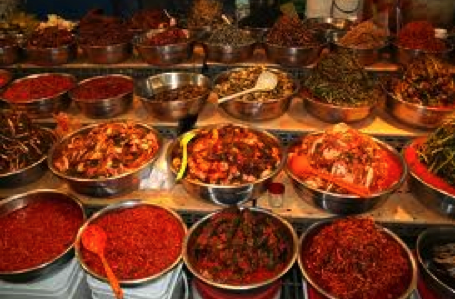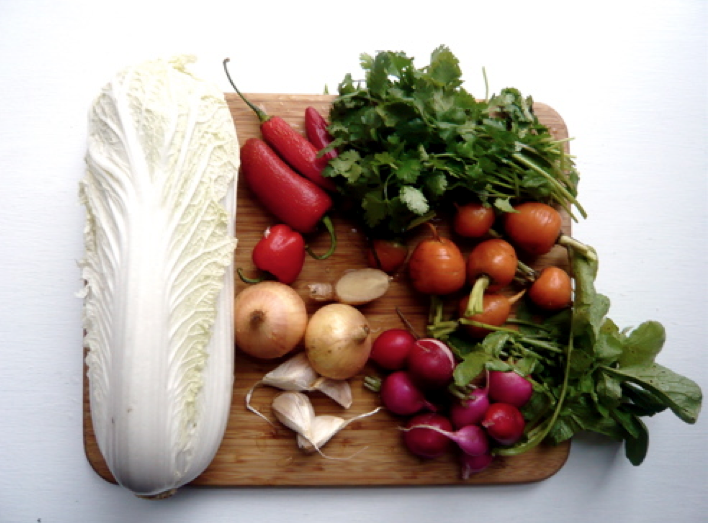

Find DJ SpecDrum at your favorite
social media outlet by clicking the images above.

It’s your dude SpecDrum here! This week I'm talking about having to wait on projects that you really want put out. Progress is well under way on my new 80’s MIXTAPE and I am surounded by such a great team that has such a great work ethic. Have you ever been working on something and been like…I really want to share this but it’s to soon? Well that is what I am going through right now!! We have just finshed working on remixes of tracks like!!
So you know with material like this it’s hard not to put it out early!! Sometimes though you have to wait unil thinks have matured into greatness on finished projects…How does this apply to food you might ask?...Well take one of my fav. Thigs to make KIMCHI…You have to wait anyware from 3days to 3 weeks for it to reach it’s maturity!!

Very basic ingredents as you can see, but food as with audio, it’s all about taking the best ingredents and carefuly mixing them to perfection! Then going back and checking and tweaking if need be to get the best possiable results!
Here is a great KIMCHI recipe courtsy of David Chang Of the Momofuko Resturant Group..
Recipe: Napa cabbage kimchi (aka Paechu kimchi)
Momofuku
Kimchi is a fermented pickle, like sauerkraut, and the fermentation process is key to its flavor. It's elemental in Korean food and in Momofuku food, and you can make it with almost anything. In northern Virginia, where I grew up, my mom and my grandmother made it with blue crabs (which was totally gross, in case you're wondering). But some kind of seafood is often added to kimchi to help kick-start the fermentation process. Raw oysters are common as are squid, shrimp, or yellow croaker. We use the jarred salted shrimp that look like krill and have a strong but still appealing and sweet shrimp aroma. A little goes a long way, and a 500-gram jar will last even an avid kimchi maker a while, so take the time and hunt one down.
The amount of salt in kimchi stops almost every kind of food-borne nastiness from working except for lactic acid bacteria, and once that bacteria starts to produce lactic acid, the pH of the whole thing drops, and nothing grows that's going to cause spoilage. My friend Dave Arnold, The Smartest Person Alive and a food-science genius, explained that to me, and he also says that using sea salt or any naturally evaporated salt will help the pickles keep and stay firmer longer because of the trace amounts of impurities you can't taste, like magnesium and calcium.
At Momofuku, we make three types of kimchi: Napa cabbage (paechu), radish (from long white Korean radishes or, failing that, Japanese daikon), and Kirby cucumber (oi). Our recipe has changed some since I learned it from my mom, who learned it from her mom. I add more sugar than they would. We let the fermentation happen in the refrigerator instead of starting the kimchi at room temperature and then moving it into the fridge when it starts to get funky. At the restaurant, we let the kimchi ferment for only a couple of weeks, instead of allowing it to get really stinky and soft. There's a point, after about two weeks, where the bacteria that are fermenting the kimchi start producing CO2 and the kimchi takes on a prickly mouthfeel, like the feeling of letting the bubbles in a soft drink pop on your tongue. It's right around then that I like it best.
Ingredients
Preparation
Cut the cabbage lengthwise in half, then cut the halves crosswise into 1-inch-wide pieces. Toss the cabbage with the salt and 2 tablespoons of the sugar in a bowl. Let sit overnight in the refrigerator.
Combine the garlic, ginger, kochukaru, fish sauce, soy sauce, shrimp, and remaining ½ cup sugar in a large bowl. If it is very thick, add water 1/3 cup at a time until the brine is just thicker than a creamy salad dressing but no longer a sludge. Stir in the scallions and carrots.
Drain the cabbage and add it to the brine. Cover and refrigerate. Though the kimchi will be tasty after 24 hours, it will be better in a week and at its prime in 2 weeks. It will still be good for another couple weeks after that, though it will grow stronger and funkier.
Serving Size
Makes 1 to 1½ quarts
I hope this inspires you to develop you own Flavor and rember don’t rush it. It takes time and attention to detail to make great KIMCHI and great Music!
So sit back, relax and listen to some great Music and enjoy your HOME MADE KIMCI!
Untilnext week this is SpecDrum signing off….PEACE